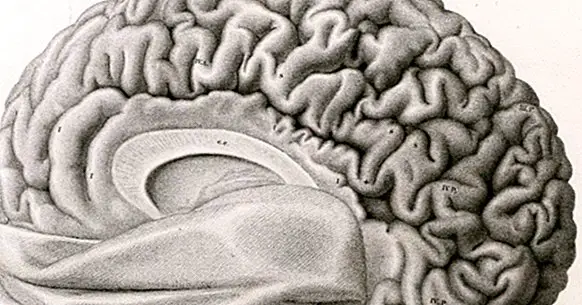The 12 most important brain diseases
In our body, the brain is the king organ . It is a fundamental structure that allows our survival and that regulates and coordinates processes as vital as breathing and heart rate, as fundamental as perception or movement or as complex as reasoning, learning, emotion and skills. executive The health of this organ is fundamental for us.
However, there are multiple conditions that can affect and damage it, with serious consequences for survival and adaptation to the environment. In this article we are going to talk about some of these conditions, brain diseases .
Diseases of the brain
There are a lot of factors that can alter the morphology and functioning of the human brain throughout the life cycle. Roughly, We can classify brain diseases in different categories , depending on its cause.
1. Diseases and genetic alterations
Some disorders and brain diseases are caused by genetic factors that alter the functioning and morphology of this organ. Certain mutations in some gene they generate an anomalous functioning of the organism, affecting in this case the brain in certain ways. This type of brain disease usually manifests in early stages of development either during fetal development or during the childhood of the individual, although in some cases the symptoms may appear in adulthood.
In this sense we can find alterations such as fragile X syndrome, Down syndrome or alterations of neuronal migration that can end up generating important mental disorders.
Another genetic disorder is found in Huntington's chorea, a genetic and neurodegenerative disease characterized by the presence of non-voluntary movements in the form of twists and turns and personality changes and the progressive loss of executive functions.
2. Metabolic diseases
The existence of metabolic diseases can cause serious damage to the brain if they are not treated, by depriving the brain of elements necessary for its development .
An example of this type of brain disease is found in the phenylketonuria, which is a metabolic disorder which causes the absence of the enzyme phenylalanine hydroxylase which in turn prevents tyrosine from being metabolized from phenylalanine, causing it to accumulate in a toxic way to the nervous system. Diabetes can also cause problems at the brain level, by specifying the glucose brain for proper functioning.
3. Diseases and strokes
The network of blood vessels that irrigate the brain and provides oxygen and nutrients necessary for survival is another element that can be altered by different diseases. Its malfunction can cause the death of brain areas more or less large depending on the type of affected vessels and their location, either by anoxia or asphyxia caused by spills .
While they are not properly diseases but rather the result of these, strokes are in fact one of the most common causes of death , we are talking about a stroke or a stroke.
Disorders such as angiopathies, the presence of aneurysms or even metabolic disorders such as diabetes can cause weakening or excessive vessel stiffness , which can break or clog.
4. Brain diseases caused by an infection
The presence of infections in the brain can cause it to stop working properly because it is inflamed and is compressed against the skull, stop receiving the substances you need to survive, that increases intracranial pressure or that is affected by harmful substances that alter their functioning or produce neuronal death.
One of the most well-known disorders is encephalitis or inflammation of the brain, in which it becomes inflamed and symptoms such as fever, irritability, discomfort, tiredness, weakness, seizures or even death . Another similar problem is meningitis or inflammation of the meninges surrounding the brain.
Apart from that, some viruses, such as rabies, or the invasion of some parasites They can also generate severe diseases. Other infections that can alter brain function are syphilis or HIV infection.
There are also diseases such as Creutzfeldt-Jakob or prion disease, which arises from an infection caused by prions or proteins without nucleic acid and that cause dementia .
5. Brain tumors
We can consider as a tumor that uncontrolled and expansive growth of the tissues of some part of the organism, which can be benign or malignant and cause a great variety of symptoms depending on the affected area . But even if we are not facing cancer, a brain tumor can pose a serious risk to survival, since it causes the brain to compress against the skull.
There are a large number of brain tumors depending on the type of cell from which the tumor arises and its degree of malignancy, such as astrocytomas, oligoastrocytomas, ependymomas or glioblastomas.
7. Neurodegenerative diseases
Many of the above diseases can be solved with the appropriate treatment or they cause an alteration that, although it may or may not limit the rest of the patient's life and evolution, maintains specific effects that do not evolve worse. However, there are multiple diseases that cause a progressive deterioration and neuronal death, with what the individual is losing capacities little by little until his death. It deals with neurodegenerative diseases.
Within these types of diseases, the best known are those they are included within the set of dementias , such as Alzheimer's, or diseases that cause them, such as Parkinson's, or the aforementioned Huntington's chorea and Creutzfeldt-Jakob disease.
Apart from these, other diseases such as multiple sclerosis and amyotrophic lateral sclerosis can also be observed, although these do not only affect the brain but also also the whole nervous system .
8. Injuries
Although head injuries are not a brain disease per se, they can cause it with extreme ease both due to the consequences of the blow in question and the backlash of the opposite part of the brain as it bounces against the skull.
Strokes can be generated very easily, as well as infections and other types of damage. For example, can break the nerve connections of the corpus callosum between the two cerebral hemispheres, or diffuse brain damage. It can also generate the hypersensitization of some groups of neurons and generate epilepsy.
9. Diseases caused by the use of substances
Other brain diseases can come from the abusive use or withdrawal of certain substances , which alter the normal functioning of the brain or destroy neurons of certain parts of the body. This is what happens for example with alcohol or certain drugs such as cocaine or heroin.
For example. we can observe disorders such as delirium tremens or Wernicke-Korsakoff syndrome (which begins in the first place by an encephalopathy in which the subject has alterations of consciousness, hallucinations, tremors to then move to Korsakoff's syndrome in which the patient presents retrograde and anterograde amnesia among other cognitive disorders).
Apart from the consumption and addiction to these substances, we can also find other types of disorders such as produced by food poisoning or poisoning for lead.
10. Malformations
The presence of congenital or acquired malformations in the brain or skull they can suppose severe alterations of the cerebral functioning, especially when they occur during the stage of growth when making difficult the normative development of the encephalon.
Some examples that stand out within this type of brain diseases are hydrocephalus, anencephaly, microcephaly or Crouzon's disease.
11. Epilepsy
Epilepsy is a brain disease that occurs due to an unbalanced functioning of neuronal groups, which are hypersensitized and they react abnormally to the stimulation .
This causes the subject to manifest alterations as seizures, sudden loss of consciousness, malaise , memory difficulties, anomie or alterations in executive functions.
This disorder can be caused by a lot of disorders and accidents, such as trauma, encephalitis, strokes, tumors or malformations. However, in some cases it is not possible to determine the cause of the crises.
- Related article: "Epilepsy: definition, causes, diagnosis and treatment"
12. Disconnection syndrome
Another highly dangerous brain disorder is the disconnection syndrome, in which one part of the brain loses connection with another or other so that Nervous information can not be integrated efficiently. One of the best known is the callus disconnection syndrome, in which for some reason the corpus callosum undergoes some type of sectioning or spill that prevents the information of one hemisphere from coordinating and traveling towards the other.



















